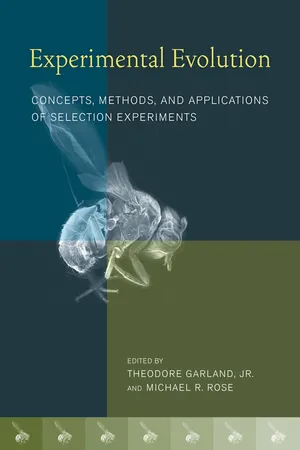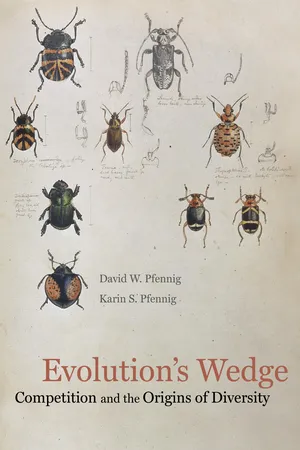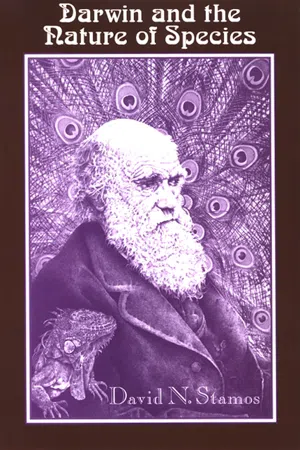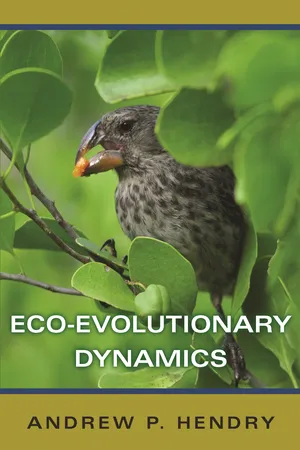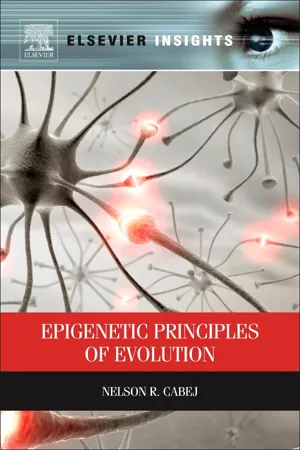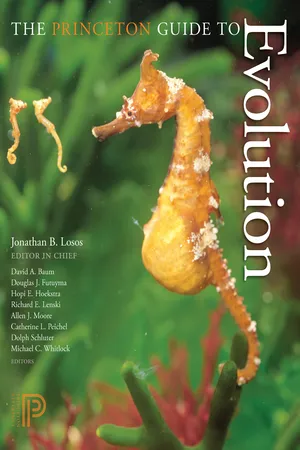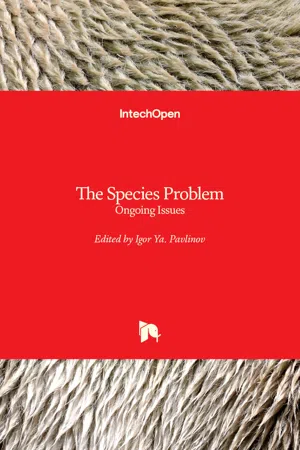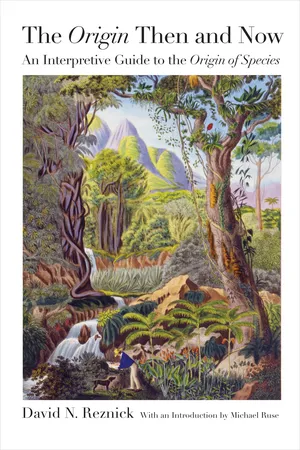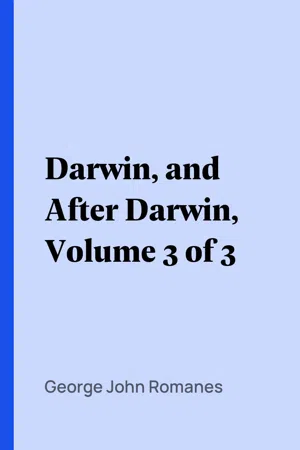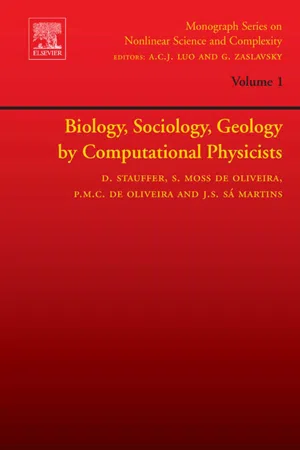Biological Sciences
Reproductive Isolation
Reproductive isolation refers to the mechanisms that prevent interbreeding between different species or populations. These mechanisms can be prezygotic, occurring before fertilization, or postzygotic, occurring after fertilization. Reproductive isolation is a key factor in the process of speciation.
Written by Perlego with AI-assistance
Related key terms
1 of 5
10 Key excerpts on "Reproductive Isolation"
- eBook - PDF
Experimental Evolution
Concepts, Methods, and Applications of Selection Experiments
- Theodore Garland, Michael R. Rose, Theodore Garland, Michael R. Rose(Authors)
- 2009(Publication Date)
- University of California Press(Publisher)
Ecological isolation can also apply to premating barriers; most notably, species that use different habitats or hosts may mate readily in the laboratory, but will rarely encounter each other in nature. Reproductive barriers can also be classified by whether they arose in the presence or absence of gene flow between the diverging populations. Allopatric speciation, in which Reproductive Isolation evolves between geographically separated populations, is accepted as the predominant mode of speciation in most groups, but the possibility of speciation with either no geographic isolation (sympatric) or only partial geographic isolation (para-patric) has gained increasing, albeit far from universal, acceptance in recent years (e.g., Via 2001; but see Coyne and Orr 2004). A final important set of distinctions involves the evolutionary factors responsible for the origin of Reproductive Isolation. Most broadly, Reproductive Isolation could evolve either due to selection or due to random genetic drift (and possibly their interaction); the relative importance of the two has long been controversial. In models that invoke selec-tion, Reproductive Isolation can evolve either as a by-product of selection on other traits (due either to pleiotropy or linkage disequilibrium) or because of selection for reproduc-tive isolation per se (most notably, in models of reinforcement, in which selection favors avoidance of mating with heterospecifics because of the low fitness of hybrids). Finally, drift can take several forms, such as single bottlenecks, repeated bottlenecks followed by population expansions (“founder-flush” cycles), and extended periods of low population size (see also Futuyma and Bennett this volume). - eBook - PDF
Evolution's Wedge
Competition and the Origins of Diversity
- David Pfennig, Karin Pfennig(Authors)
- 2012(Publication Date)
- University of California Press(Publisher)
This divergence then favors the evolution of Reproductive Isolation between these populations. S P E C I A T I O N • 181 As first noted by Mayr (1942, 1963) and Dobzhansky (1937, 1940) — two early propo-nents of the biological species concept — Reproductive Isolation (that is, a lack of gene flow) is important in defining species because — in the absence of gene flow between groups of organisms — different patterns of selection, random genetic drift, and muta-tion will send those groups on separate evolutionary trajectories and thereby cause them to evolve independently of each other. By contrast, when groups of organisms exchange genes via interbreeding, each group tends to lose its evolutionary independence and also its distinctive characteristics. Under the biological species concept, speciation is tantamount to the evolution of Reproductive Isolation. However, Reproductive Isolation is a graded condition, in that the amount of gene flow — and therefore, the degree of Reproductive Isolation — varies for different interacting groups or species (Grant 1971; Mallet 2008; Nosil 2008). Indeed, there is a continuum in nature that ranges from randomly mating populations to par-tially reproductively isolated populations or ecomorphs, to species that hybridize, and finally to completely reproductively isolated species (Mallet 2008). The existence of such a continuum implies that the evolution of Reproductive Isolation (and, hence, speciation) is not an event but rather a process (Coyne and Orr 1989, 2004; Harrison 1998; Grant and Grant 2008; Mallet 2008; Harrison 2010). Moreover, the continuous nature of the speciation process means that it is often not possible to pinpoint precisely when a new species arises (Ridley 1996). Because Reproductive Isolation is crucial for delineating species, identifying the fac-tors that preclude gene flow between populations, and evaluating why these factors evolve, is crucial for understanding the speciation process. - eBook - PDF
- David N. Stamos(Author)
- 2012(Publication Date)
- SUNY Press(Publisher)
As Mayr (1970) points out, sterility is only one of the reproductive iso- lation mechanisms in the biological species concept. According to this con- cept, a species is one or more actually or potentially interbreeding populations separated from other species by Reproductive Isolation mechanisms (12). These mechanisms, all of which “have a partially genetic base” (56), divide into two classes (57), namely, premating (seasonal and habitat isolation, etho- logical isolation, and mechanical isolation, an example of the latter being no sperm transfer), and postmating (gametic mortality, zygotic mortality, hy- brid inviability, and hybrid sterility). The biological species concept, as Mayr further points out, is a “relational” concept, like “brother,” such that it is log- ically impossible for the world to have only one species (13–14). Mayr’s biological species concept emphasizes what keeps species apart. There are a number of other species concepts, however, which emphasize what keeps a species together. Perhaps the most important of these is Hugh Paterson’s (1985) recognition species concept. Originally Paterson charac- terized a species in terms of what he called a “specific-mate recognition sys- tem,” defined as a signaling system between appropriate mating partners or their cells. Each species for Paterson had its own distinct specific-mate recognition system. However, due to the fact that many good species share a common specific-mate recognition system (as with several species of orchids from different genera), Paterson in his 1985 paper (which still 108 DARWIN AND THE NATURE OF SPECIES retained the name of his older species concept) expanded the original def- inition to something more inclusive, namely, a distinct fertilization system (which includes the specific-mate recognition system as a subclass). - eBook - ePub
- Andrew P. Hendry(Author)
- 2016(Publication Date)
- Princeton University Press(Publisher)
increased through an opposing reproductive “enhancer” (Hendry 2009). For example, colorful low-predation male guppies moving downstream over waterfalls into high-predation sites, where resident males are drab, might have lower survival (barrier: Weese et al. 2011) but higher mating success (enhancer: Schwartz and Hendry 2006, Labonne and Hendry 2010). Third, reproductive barriers are often assessed in artificial situations, such as the laboratory, and thus might not accurately reflect isolation in nature. For example, assortative mate choice in stickleback can be evident in the lab (McKinnon et al. 2004) but not in mesocosms or in nature (Jones et al. 2006, 2008). Fourth, reproductive barriers/enhancers are often asymmetric, constraining gene flow from one group into another while sometimes enhancing it in the reverse direction (Ellers and Boggs 2003, Forister 2004, Räsänen and Hendry 2014).For all of the above reasons, the best studies examine multiple potential barriers in multiple populations in multiple ecological and geographical contexts (e.g., McKinnon and Rundle 2002, Nosil 2007, Jiggins 2008, Lowry et al. 2008b), and yet additional reproductive barriers and contexts could be considered in all natural systems. Given this necessary limitation, it is useful to focus first on barriers that would act early in a potential introgression event, such as habitat preference, selection against migrants, and temporal isolation. The reason is that later-acting barriers can only reduce gene flow that remains following early acting barriers—and meta-analyses have shown that early acting barriers do much of the job in ecological speciation (Coyne and Orr 2004, Nosil et al. 2005, Lowry et al. 2008a, Schemske 2010). In addition, it is good practice to combine “integrated measures of ecological speciation” with the reproductive barrier approach.Ecological speciation in natureEcological differences have been thought to promote speciation ever since Darwin (1859), and this recognition was an important part of the modern synthesis (Dobzhansky 1940, Simpson 1944, 1953b, Lack 1947, Mayr 1947, 1963). However, it wasn’t until the last 20 years or so that the field really took off with the formal exposition of the ecological theory of adaptive radiation and the role of ecological speciation therein (Schluter 2000a, Coyne and Orr 2004, Rundle and Nosil 2005, Nosil 2012). At present, evolutionary biologists don’t question the fact that divergent selection can cause adaptive divergence which can contribute to the evolution of Reproductive Isolation. Yet many open questions remain that we can here consider, such as (Q1) how often is speciation ecological? (Q2) how often do ecological differences cause speciation? (Q3) how fast is ecological speciation? and (Q4) how “fragile” (prone to collapse) is it? Other topics address potential contributors to ecological speciation, including the importance of (Q5) competition within and among species, (Q6) “reinforcement” of mating preferences to avoid maladaptive between-type mating, (Q7) “magic” traits that are both under divergent selection and promote Reproductive Isolation, (Q8) the dimensionality (number of independent axes) of selection and adaptation, and (Q9) sexual selection that might promote or constrain mating isolation. As usual, I will address these questions by reference to meta-analyses whenever possible; otherwise I will provide key examples and speculate on their possible generality. - eBook - ePub
- Nelson R Cabej, Nelson R. Cabej(Authors)
- 2011(Publication Date)
- Elsevier(Publisher)
not isolated, i.e., they are “potentially interbreeding” groups and, in many cases, their offspring gives birth to viable and fertile offspring. This shows that the reproductive incompatibility and postzygotic isolation as criteria for biological species definition are not universally true.Later, due to inherent flaws of the definition and problems arising from recognition of the BSC, numerous attempts have been made to redefine the concept of species. (24 named species concepts were known until in 1997 (de Queiroz, 2005 ).) It is not within the scope of this discussion to review different species definitions still in currency in the biological community.By emphasizing the role of Reproductive Isolation in the process of speciation, the BSC underestimates (while implying) the most important cohesive force of the species, the mate recognition system, which represents the deeper causal mechanism responsible for establishing Reproductive Isolation between populations of the original species. Reproductive Isolation is determined by neurocognitive mating decisions on the basis of mate preferences.Observations on a number of morphologically and genetically sibling (cryptic) species lend some weight to Paterson’s (1985) recognition species concept (RSC), which, in distinction from the BSC, views the reproductive compatibility within the group as a basic criterion of species definition. Paterson’s RSC maintains that species is the most inclusive population of biparental organisms sharing a common fertilization system, and it is based on mate preferences and the specific mate recognition system (matching of copulatory organs, courtship behavior, and neuroendocrine communication, as well as temporal sequence of associating reproductive events). The concept emphasizes the reproductive unity of the group rather than its differences with other groups. The Reproductive Isolation results from a change in the mate recognition system, which creates “a common fertilization system” in a group of individuals of a species.The species recognition concept is also not applicable to asexual organisms. Both RSC and BSC would deny the status of species to many organisms that, under natural conditions, do not hybridize but can hybridize and produce fertile hybrids under special conditions. - eBook - ePub
- David A. Baum, Douglas J. Futuyma, Hopi E. Hoekstra, Richard E. Lenski, Allen J. Moore, Catherine L. Peichel, Dolph Schluter, Michael C. Whitlock, David A. Baum, Douglas J. Futuyma, Hopi E. Hoekstra, Richard E. Lenski, Allen J. Moore, Catherine L. Peichel, Dolph Schluter, Michael C. Whitlock(Authors)
- 2013(Publication Date)
- Princeton University Press(Publisher)
Another very important point to keep in mind when studying speciation is that Reproductive Isolation driven and maintained by ecological natural selection can collapse when environmental conditions change. A classic example of such species collapse involves cichlid fish in Lake Victoria, Africa—species that occur at different depths. The gradient of light quality correlated with depth has driven evolutionary changes in a light-absorbing opsin gene. It is thought that the local adaptation of female light perception to light at different depths has in turn led to changes in their preference for male coloration. Males of fish in shallow water, where blue wavelengths of light are abundant, have evolved blue coloration. Males occurring in deeper water, where available light is shifted to the red end of the visible light spectrum, are colored red. Under normal clear-water conditions, assortative mating occurs within deep and shallow populations because female cichlids prefer males that have the most visible colors. The recent introduction of anthropogenic pollution to the lake changed the way light passes to different water depths. This altered visibility has led to interbreeding followed by the collapse of closely related species. Eric B. Taylor, Janette W. Boughman, and others recently documented a similar collapse of deep- and shallow-water stickleback ecotypes in Enos Lake, British Columbia. In that case, changes to the lake caused by the introduction of a foreign crayfish apparently led to a breakdown of assortative mating. Thus, while ecological barriers are thought to evolve quickly during the process of speciation, they may not be sufficient to maintain species boundaries into the future.Finally, it is challenging to infer whether divergent populations and ecotypes will ever become distinct species. It is clear from decades of research that not all adaptations within a species are necessarily involved in speciation. A major goal of speciation research is to determine why some adaptations are important to the process of speciation while other adaptations segregate within species without leading to appreciable Reproductive Isolation.4. REINFORCEMENTReinforcement - eBook - PDF
The Species Problem
Ongoing Issues
- Igor Ya. Pavlinov(Author)
- 2013(Publication Date)
- IntechOpen(Publisher)
Behavioral bonds provide cohesiveness of species. Species-specific behavior implies op‐ erating of special connections between the individuals, which transform the species into or‐ ganization with the function of survival. Primarily, these are the connections accountable for the interbreeding and Reproductive Isolation, which make a species a genetically closed mo‐ nad. Reproductive Isolation is determined by the mutual affinity of organisms. The affinity is not limited by choosing a mating partner; it includes all the intraspecies interactions as distinct from the interspecies ones. Reproductive Isolation and preventing inbreeding are two opposite “forces”, analogous to the attraction and repulsion, the proper balance of which is a necessary precondition for a species existence. Both inbreeding and promiscuous sexual behavior are destructive for a species. What is “the proper balance”? What is the final state this balancing is aimed at? It is an optimal species gene pool. Genetically, a species as a whole is a closed system. Parts of the species (groups, demes) are potentially capable for substantive existence in nature. This capability is analogous to the ca‐ pability of plants and lower animals to regenerate the whole body from the parts. As such, this is not speciation. The absence of the physical skin hampers us to grasp a species as a unity. But it is only a matter of habit and imagination. Behavioral bonds are common in biol‐ ogy. They unite families, groups, tribes, armies, companies, states, and humankind. Biological Species as a Form of Existence, the Higher Form http://dx.doi.org/10.5772/53309 77 The transition from genome to genetic pool is far from being the whole story. Genetic pool, similar to genome, is not a substantive entity. It is reproduced by a generation of the deme as its part, its attribute. The necessity to reproduce a genetic pool drastically changes the bio‐ logical status of the individual organisms. - eBook - ePub
The Origin Then and Now
An Interpretive Guide to the Origin of Species
- David N. Reznick(Author)
- 2011(Publication Date)
- Princeton University Press(Publisher)
A second version of allopatric speciation occurs when two populations diverge while they are isolated from one another, but can still interbreed when they come back into contact. If this occurs, then the process of reinforcement can finalize the evolution of Reproductive Isolation (see chap. 8). If the reunited populations are adapted to use the environment in a different way or have different attributes that make males attractive to females, then a hybrid between the two may be “neither fish nor fowl” in the sense that it will not be as good as either parent in earning a living or finding a mate. If this occurs, then natural selection can act against those individuals from either population that make the mistake of mating with a member of the other population, since the offspring they produce will be inferior to those produced from matings within each population. Natural selection against such mistakes cuts the cord that joins the two incipient species. Reinforcement thus represents a departure from Darwin’s view on the evolution of Reproductive Isolation, since in this case it is natural selection that causes Reproductive Isolation to evolve, but at the same time reinforcement restores natural selection as playing an important role in speciation.Speciation can also happen without geographic isolation. One version of “nonallopatry” is sympatric speciation, or the formation of reproductively isolated populations within what had once been a single species. We think that sympatric speciation will most readily occur when there is a genetic association between habitat choice, fitness in alternative habitats, and mating preference. Imagine an organism that has two habitats to choose from. It has genetic variation for habitat choice, genetic variation for traits that influence how successful it will be in either habitat, and genetic variation for the mate that it will choose. When an individual chooses habitat A, its success at earning a living in that habitat will be a function partly of whether it has the right genotype to perform well there. It will produce more successful offspring if it also has a genotype that causes it to prefer to mate with an individual that shares these attributes. When all these conditions are satisfied, then it is possible for a single population of organisms to split into two, each specialized on one of the alternative habitats and each preferring to choose a mate from its own population without the two incipient species ever having been geographically isolated from one another. However, the number of conditions that must be satisfied for sympatric speciation is many more than the number required for allopatric speciation. Allopatry requires nothing beyond populations being geographically isolated. Newly developed theory argues that sympatric speciation can occur. Laboratory experiments have documented the evolution partial Reproductive Isolation in sympatry, and there are some undisputed cases of sympatric speciation in nature. None of this evidence tells us how often it occurs relative to other forms of speciation. - eBook - ePub
Darwin, and After Darwin, Volume 3 of 3
Post-Darwinian Questions
- George John Romanes(Author)
- 2011(Publication Date)
- Perlego(Publisher)
degree is their interbreeding prevented, and, therefore, opportunity is given for a subsequent divergence of type, whether by the influence of independent variability alone, or also by that of natural selection, as now acting more or less independently on each of the partially separated groups. In short, all that was said in the foregoing chapters with respect to isolation in general, here applies to physiological isolation in particular; and by supposing such isolation to have been the prior change, we can as well understand the subsequent appearance of morphological divergence on continuous areas, as in other forms of isolation we can understand such divergence on discontinuous areas, seeing that even a moderate degree of cross-infertility may be as effectual for purposes of isolation as a high mountain-chain, or a thousand miles of ocean.Here, then, are two sharply-defined theories to explain the very general fact of there being some greater or less degree of cross-infertility between allied species. The older, and hitherto current theory, supposes the cross-infertility to be but an accident of specific divergence, which, therefore, has nothing to do with causing the divergence. The newer theory, on the other hand, supposes the cross-infertility to have often been a necessary condition to the divergence having begun at all. Let us now consider which theory has most evidence in its favour.First of all we have to notice the very general occurrence of the fact in question. For when we include the infertility of hybrids, as well as first crosses, the occurrence of some degree of infertility between allied species is so usual that Mr. Wallace recommends experiments to ascertain whether careful observation might not prove, even of species which hybridize, "that such species, when crossed with their near allies, do always produce offspring which are more or less sterile inter se[19] - Dietrich Stauffer, Suzana Maria Moss de Oliveira, Paulo Murilo Castro de Oliveira, Jorge Simoes de Sá Martins(Authors)
- 2006(Publication Date)
- Elsevier Science(Publisher)
The main point of Mayr’s theory was that geographically isolated populations can diverge freely, while those found in sympatry (sharing the same habitat) can only escape from the homogenising effects of gene flow under very special circumstances. Such a point of view has been the dominant one for many decades, turning sympatric speciation an extremely controver-sial process. Recently, however, a variety of approaches and laboratory studies have provided increasing evidence that Reproductive Isolation may set in due to multiple selective forces, suggesting that sympatric speciation can be in fact a rather common phenomenon ( Rice and Hoster, 1993; Tregenza and Butlin, 1999; Odeen and Florin, 2000 ). One of the most important ingredients to obtain sympatric speciation is sexual selection, that is, mating partners are chosen assortatively instead of randomly. We may say that sexual selection plays the role of a geographical barrier preventing mating between individuals of too different phenotypes. But how does assortative mating develop? Consider for instance an ecology which presents a broad distri-bution of seed sizes such that birds that feed on these seeds can equally compete for them, independently of their beak sizes. Suppose now that due to oscillations in the rainfall regime, this distribution of seed sizes becomes bimodal, peaked at very large and very small seeds. In this case the number of birds with inter-mediate beak sizes rapidly decreases, since they lose out in competition for either resource. So the establishment of a bimodal distribution of resources provokes the so called disruptive selection which splits the population into two distinct ecolog-ical characters determining adaptation to the environment. Such a splitting of the ecological character is called polymorphism and may be considered as a first step towards sympatric speciation.
Index pages curate the most relevant extracts from our library of academic textbooks. They’ve been created using an in-house natural language model (NLM), each adding context and meaning to key research topics.
